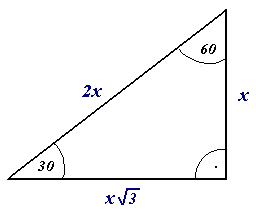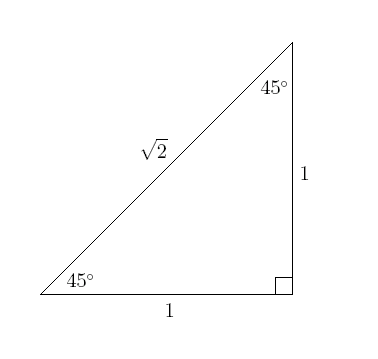 |
(http://upload.wikimedia.org/wikipedia/commons/1/15/Triangle_30-60-90_rotated.png)
|
1. The triangle above is a 30 degree triangle, the numbers around the edges are used as r (2x) x (y) and x rad 3(x). When we are using the ordered pairs we make r equal one and change the others so that the x remains the same.
 |
| (http://www.biology.arizona.edu/biomath/tutorials/trigonometric/graphics/trig_45_45_90.gif) |
2 The triangle to the left is a 45 degree triangle, and the major difference from the 30 degree triangle is that the x and y for this one are the same, we still want to have r be equal to 1.
| (https://encrypted-tbn1.gstatic.com/images?q=tbn:ANd9GcSUNhcyisjWpCaS61paVeoUvRYhYy01bc8iwclnXcNPlLpNSqoxfQ) |
3. This is the 60 degree triangle which is similar to the 30 degree triangle, we can see that the x and y are switched.
 |
| (http://literacy.purduecal.edu/STUDENT/mrrieste/quadrant1.png) |
 |
(http://1.bp.blogspot.com/-
Hr1ntVrUUK0/UF3p3LuRbLI/AAAAAAAAB5M/NMsjZCmV_vk/s1600/complete+unit+circle.jpg)
|
5. The same triangles go all the way around the unit circle, as we can see from the image to the left, the values obtain different signs when they are in different quadrants. In quadrant 1 they are all positive, in quadrant 2 the x's are negative and the y's are positive. In the 3rd quadrant they are both negative and in the 4th quadrant the y's are negative and the x's are positives.
Inquiry Activity Reflection
1. The coolest thing I learned from this activity is that the lines on a unit circle are really all just the same three triangles all the way around.2. This activity will help me in this unit because it made it easier for me to see that we add by 30 or 15 or 60 because these are the degrees of the three triangles.
3. Something I never realized about the special right triangles was that the ordered pairs on the unit circle are just the x and y after we make r equal to 1.
Works Cited
1. http://upload.wikimedia.org/wikipedia/commons/1/15/Triangle_30-60-90_rotated.png
2. http://www.biology.arizona.edu/biomath/tutorials/trigonometric/graphics/trig_45_45_90.gif
3. http://literacy.purduecal.edu/STUDENT/mrrieste/quadrant1.png
4. https://blogger.googleusercontent.com/img/b/R29vZ2xl/AVvXsEhH5ODpWbs47DCsR3WqGkJuxN_cT5GuWsgOW6jXXdLULLfVds02yP_m-PeVS6DOUus3XxYhrFd6MEgTPmPEE3YIpSrJKbrq0GqFIjenPq7gDV21eErAVpSWVSTY3O29AxQqIt9w3wRaha4T/s1600/complete+unit+circle.jpg
5. https://encrypted-tbn1.gstatic.com/images?q=tbn:ANd9GcSUNhcyisjWpCaS61paVeoUvRYhYy01bc8iwclnXcNPlLpNSqoxfQ
5. https://encrypted-tbn1.gstatic.com/images?q=tbn:ANd9GcSUNhcyisjWpCaS61paVeoUvRYhYy01bc8iwclnXcNPlLpNSqoxfQ

